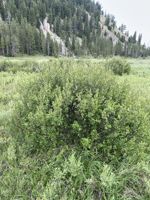Mon-Fri 9am - 5pm Mountain time
Washington Hawthorn vs Dwarf-Bog Birch
Crataegus phaenopyrum
Betula glandulosa
CUSTOM GROW
CUSTOM GROW
Washington Hawthorn is an attractive ornamental shrub that is dense enough to plant as a privacy screen. It produces clusters of white blooms in late spring to early summer.
Washington Hawthorn's red berries last throughout winter, bringing squirrels and birds to your property. In the fall, its foliage turns beautiful orange, scarlet, or purple.
One of the most overlooked trees on the prairies. This tree is often used as rootstock, a wildlife attractor, or a boulevard hedge. Give this one a second look.
This species is also known as one of the more salt-tolerant species for those with saline soils.
Please note: this plant is poisonous to dogs.
Dwarf-Bog Birch is a native, cold-hardy shrub that can be found across most of Canada. Its preference for moist soils and the extensive root system make it well-suited for riparian zone plantings, soil stabilization, and erosion control projects.
It features small, round, leathery leaves with scalloped edges and produces small, cone-like catkins. A distinguishing characteristic of the Dwarf-Bog Birch is the presence of large resin glands on the branches and the undersides of the leaves. These resin glands are the reason for its scientific name, Betula glandulosa.
Note: We use Dwarf-Bog Birch for Betula glandulosa. This species is also known by many other common names, including Bog Birch, Dwarf Birch, Glandular Birch, and others. Please confirm the scientific name to ensure you are ordering the correct plant.
Washington Hawthorn Quick Facts
Dwarf-Bog Birch Quick Facts
In row spacing: 0.9 m (3 ft)

